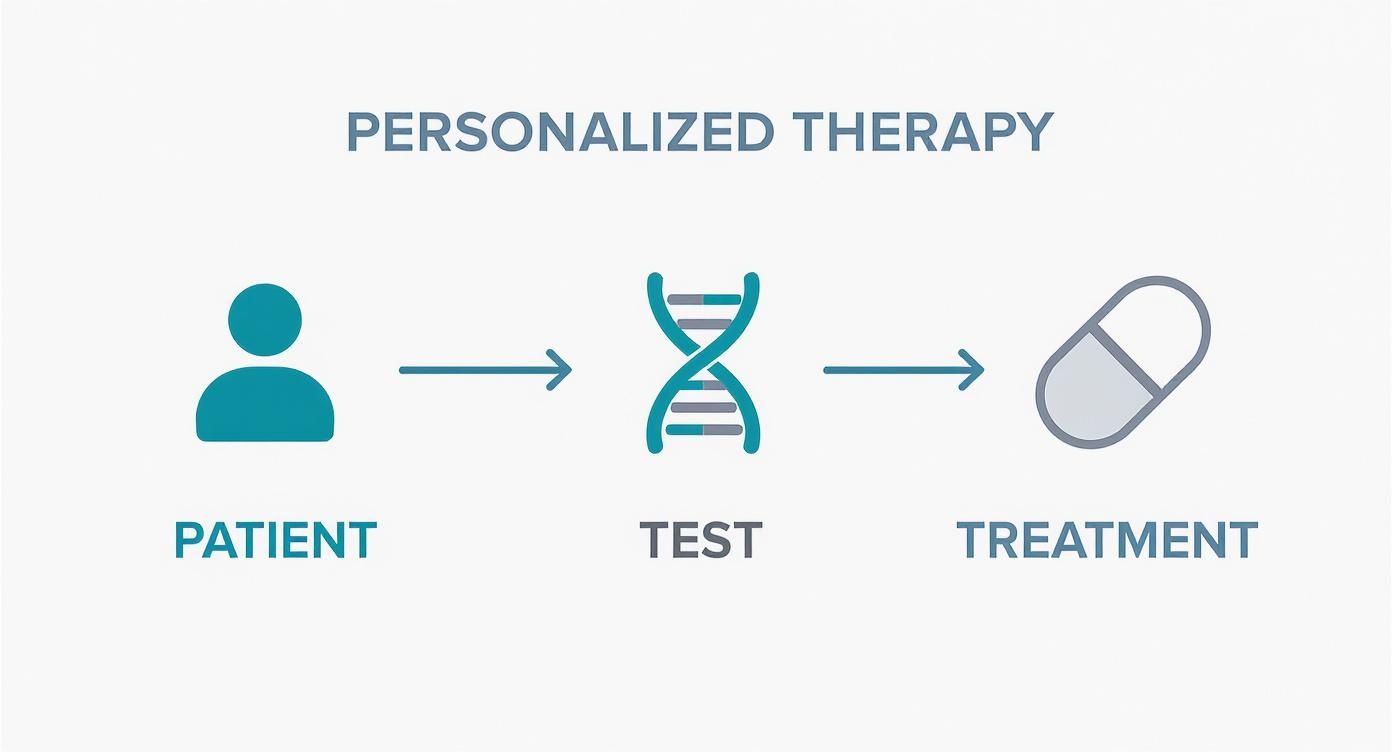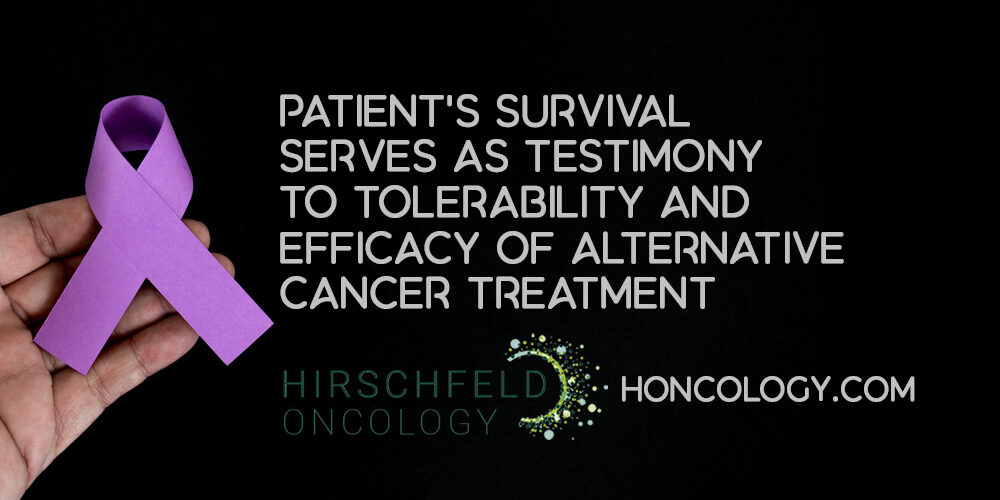Hearing the words "pancreatic cancer" can feel overwhelming, but the first step toward taking back a sense of control is understanding what lies ahead. The mainstays of treatment are surgery, chemotherapy, and radiation therapy, which we often use together in different combinations. We're also seeing newer, more precise approaches like targeted therapy and immunotherapy change the game for many patients.
Navigating Your Pancreatic Cancer Treatment Path

A new diagnosis brings a whirlwind of questions and a lot of uncertainty. This guide is here to help clear the fog, breaking down the medical terms and treatment plans you'll be discussing. Think of it as a map for the journey ahead. Each option is a potential route, and your oncology team will be your guide, helping you chart the best course based on your specific circumstances.
Our aim is to provide you with the knowledge to have clear, confident conversations with your doctors. When you understand the landscape, you're in a much better position to be an active partner in your own care.
What Determines Your Treatment Plan?
Every person's cancer is different, almost like a fingerprint. Because of this, there's no one-size-fits-all treatment plan. Your oncology team will look at several key pieces of the puzzle before recommending a path forward.
A few of the most important factors include:
- The stage of the cancer: Is the tumor confined to the pancreas, or has it spread to nearby tissues, blood vessels, or other parts of the body? Cancers caught at an earlier stage are more likely to be candidates for surgery.
- The tumor’s location: A tumor in the head of the pancreas might require a different type of operation than one in the body or tail.
- Your overall health: Your general fitness, age, and any other health conditions you may have are crucial for determining which treatments you can safely tolerate.
- Genetic and molecular markers: Sometimes, the tumor cells have specific genetic mutations that make them vulnerable to specialized treatments like targeted therapy.
Pancreatic cancer is a complex disease. In fact, fewer than 20% of patients are eligible for surgery when they are first diagnosed, usually because the cancer has already spread. This is a stark reminder of why treatments like chemotherapy and radiation are so essential in our toolkit.
Getting a handle on these factors is the starting point for understanding your team's recommendations. For a deeper dive into the disease itself, you can explore our detailed guide on pancreatic cancer. This background will help you feel more prepared for the detailed conversations to come about surgery, systemic therapies, and other advanced treatments.
The Three Pillars of Pancreatic Cancer Care

When you're facing a pancreatic cancer diagnosis, understanding the treatment plan is the first step toward regaining a sense of control. The approach to fighting this disease is built on three well-established strategies: surgery, chemotherapy, and radiation therapy.
Think of them as a specialized toolkit. Surgery is for removal, chemotherapy provides system-wide control, and radiation offers targeted, high-powered precision. Each plays a distinct role, but they are often combined to create a strategy that’s right for you.
Surgery: The Foundational Option for Removal
The main goal of surgery is powerful and direct: to remove the entire tumor. It’s like pulling a weed out of a garden—you have to get the whole root to stop it from coming back. This is why surgery, when possible, offers the best chance for long-term control of the disease.
But it’s not an option for everyone. For an operation to be successful, the cancer must be "resectable," which means it's confined to the pancreas and hasn't entangled itself with major blood vessels or spread to other parts of the body.
The most common—and most complex—operation for pancreatic cancer is the Whipple procedure, also called a pancreatoduodenectomy. This is typically used for tumors located in the head of the pancreas.
During a Whipple, the surgeon removes:
- The head of the pancreas
- The first part of the small intestine (the duodenum)
- The gallbladder and a portion of the bile duct
- Sometimes, a small section of the stomach
The surgeon then meticulously reconnects everything to restore the normal flow of the digestive system. For tumors in the middle or end of the pancreas, a distal pancreatectomy—a less extensive surgery that may also involve removing the spleen—is often performed.
Chemotherapy: A Systemic Approach to Fighting Cancer
While surgery is a local fix, chemotherapy works throughout your entire body. It uses powerful drugs to find and destroy cancer cells wherever they might be hiding, whether they’re big enough to see on a scan or are just microscopic stragglers.
Think of it as a security patrol that circulates through your whole system, searching for rogue cells that may have broken away from the main tumor. Because pancreatic cancer can be aggressive, this is a crucial step.
Chemotherapy is vital because even after a successful surgery, microscopic cancer cells can remain. Using chemotherapy after surgery—known as adjuvant therapy—is a standard practice that significantly reduces the risk of the cancer returning.
Chemotherapy can also be given before surgery (neoadjuvant therapy) to shrink a tumor. This can sometimes make a "borderline resectable" tumor small enough to be safely removed. For patients whose cancer has already spread, chemotherapy becomes the main treatment to control the disease, ease symptoms, and maintain quality of life.
Radiation Therapy: Using Energy to Target Tumors
The third pillar, radiation therapy, uses high-energy beams, like X-rays, to damage and destroy cancer cells in a very specific, targeted area. If surgery is like physically pulling out the weed, radiation is like using a magnifying glass to focus sunlight and burn it away without harming the surrounding plants.
Radiation is frequently paired with chemotherapy in a strategy called chemoradiation. The chemo drugs actually make the cancer cells more vulnerable to radiation, creating a potent one-two punch. This is especially helpful for shrinking tumors away from critical blood vessels before attempting surgery.
To put the challenge into perspective, pancreatic cancer is projected to cause around 51,980 deaths in the United States in 2025 alone, making it the third leading cause of cancer-related death. Sadly, due to diagnoses often happening at later stages, surgical removal is only possible for fewer than 20% of patients. This reality underscores why chemotherapy and radiation are so critical for the vast majority of people diagnosed. You can find more detailed statistics about pancreatic cancer prevalence from the Pancreatic Cancer Action Network.
For patients who aren't candidates for surgery, radiation can also be used as palliative care. By shrinking tumors that are pressing on nerves or blocking ducts, it can provide significant relief from pain and other symptoms, dramatically improving a person’s comfort.
To help you see how these treatments fit together, here is a quick overview of their primary roles in pancreatic cancer care.
Overview of Standard Pancreatic Cancer Treatments
Together, these three pillars—surgery, chemotherapy, and radiation—form the bedrock of treatment. They are the tools we use, often in careful combination, to build the most effective and personalized plan in the fight against pancreatic cancer.
Moving Beyond the Standard Playbook: Targeted and Advanced Treatments
For decades, the mainstays of cancer treatment were surgery, chemotherapy, and radiation. While still crucial, we're now entering an era of more personalized medicine. The focus is shifting from a one-size-fits-all strategy to treatments that are custom-built for the unique biological signature of an individual's tumor. Two of the most promising frontiers in this new landscape are targeted therapy and immunotherapy, which are carving out new paths of hope for patients with pancreatic cancer.
These newer treatments work from a completely different playbook. Instead of broadly attacking all fast-growing cells like chemotherapy does, they zero in on what makes a cancer cell unique. This precision can often lead to better outcomes with more manageable side effects.
Targeted Therapy: A Smart Key for a Specific Lock
Think of a cancer cell as having a very specific "lock" on its surface—a protein or a genetic fluke that it absolutely needs to grow and spread. Targeted therapy is like a "smart key" crafted to fit that one specific lock and nothing else. By blocking that pathway, the treatment effectively cuts the cancer cell's lifeline, stopping it in its tracks without causing the same level of collateral damage to healthy cells.
It's a more strategic approach. We're not carpet-bombing the system; we're finding and exploiting a specific weakness inside the cancer itself.
So, how do we find these "locks"? It all comes down to sophisticated testing:
- Genetic Testing (Germline): This involves a simple blood or saliva test to look for inherited genetic mutations, like BRCA1 or BRCA2, that are present in every cell of your body. Around 10% of pancreatic cancers are tied to these kinds of hereditary factors.
- Molecular Profiling (Somatic): Here, we analyze the tumor tissue itself to map out the genetic mutations that have occurred only within the cancer cells. This gives us a detailed blueprint of the tumor’s unique vulnerabilities.
These tests are absolutely essential because they tell us who is most likely to respond. For instance, we know that patients with BRCA mutations can have a fantastic response to drugs called PARP inhibitors, which cleverly exploit a flaw in how these specific cancer cells repair their DNA. To get a better sense of how these precise medications work, you can read our in-depth article on targeted therapy and its growing role in cancer care.
A pivotal study in Lancet Oncology drove this point home, showing that pancreatic cancer patients who received treatments matched to their tumor's molecular profile lived longer than those who didn't. This is exactly why molecular testing is becoming a non-negotiable part of building an effective treatment plan right from the start.
Immunotherapy: Waking Up Your Body’s Own Defenses
Another game-changing strategy is immunotherapy. What's fascinating is that it doesn't attack the cancer directly at all. Instead, it acts as a catalyst, unleashing your own immune system to do the job it was born to do: hunt down and eliminate abnormal cells.
Here's a simple way to think about it. Cancer cells are masters of disguise. They often find clever ways to put up a "shield" that makes them invisible to your T-cells—the security guards of your immune system. Immunotherapy drugs, especially a class known as checkpoint inhibitors, essentially rip that shield away.
With the cancer's cover blown, the T-cells can finally see the enemy, recognize it as a threat, and launch an attack. This approach can lead to remarkably durable, long-lasting responses because it's essentially teaching your own body how to control the cancer.
Who Actually Benefits from These Advanced Treatments?
It’s critical to set clear expectations here. While these therapies are powerful, they aren't a magic bullet for every patient with pancreatic cancer. Right now, their effectiveness is largely limited to patients whose tumors have very specific biological markers.
For immunotherapy, one of the most important biomarkers is known as microsatellite instability-high (MSI-H) or mismatch repair deficiency (dMMR). These are technical terms for a simple concept: the cancer cells have a faulty DNA repair system, which causes them to accumulate a huge number of mutations. To the immune system, these highly mutated cells look incredibly strange and foreign, making them an easy target once immunotherapy has taken down their defenses.
While only a small fraction of pancreatic cancer patients have these particular biomarkers, the results for those who do can be life-changing. The good news is that researchers are working tirelessly in clinical trials to identify new targets and expand the number of patients who can benefit from these precise and powerful therapies, constantly pushing the boundaries of what we thought was possible.
How Doctors Combine Treatments for Better Results
Treating pancreatic cancer isn't a one-and-done event. A single therapy, like surgery on its own, is rarely enough to keep the cancer at bay for the long term. Instead, your oncology team will map out a strategy that combines different treatments in a very specific, carefully timed order.
Think of it less like a single battle and more like a coordinated campaign. Each treatment—surgery, chemotherapy, radiation—is a specialized unit with a distinct role. When they work together, their combined force is far more powerful than what any one of them could achieve alone. This layered approach is designed to hit the cancer from multiple angles at different stages, giving you the best shot at a good outcome.
Understanding the "why" behind this strategy is key, as it explains why your care plan will likely unfold in several phases over many months.
Preparing the Battlefield with Neoadjuvant Therapy
Sometimes, jumping straight to surgery isn't the best first move. If a tumor is large or wrapped around major blood vessels, surgeons call it "borderline resectable." Trying to remove it right away is risky and increases the chances of leaving cancer cells behind.
This is where neoadjuvant therapy comes into play. It's simply treatment—usually chemotherapy, sometimes with radiation—that you receive before surgery.
There are a few clear goals here:
- Shrink the tumor: A smaller tumor is easier to remove. The hope is to pull it away from those critical blood vessels, turning a high-risk operation into a much safer, more effective one.
- Test the cancer's response: Watching how the tumor reacts to chemotherapy gives us invaluable clues about its biology. We learn which drugs work best against your specific cancer.
- Hit hidden cells early: This approach immediately attacks any microscopic cancer cells (micrometastases) that might have broken away from the main tumor but are too small for any scan to detect.
By weakening the cancer first, we give the surgeon the best possible chance of achieving a "negative margin." That's the medical term for removing the entire tumor with a clean edge of healthy tissue all around it, which is a critical factor in preventing the cancer from coming back.
Securing the Area with Adjuvant Therapy
Even after a perfect surgery that removes all visible signs of cancer, there's always a risk that microscopic cells have been left behind. These stray cells are like hidden seeds, capable of sprouting into new tumors down the road. This risk of recurrence is one of the biggest challenges we face in pancreatic cancer.
To fight this, your team will almost always recommend adjuvant therapy, which is treatment given after surgery has healed. Most often, this means a course of chemotherapy.
The purpose of adjuvant therapy is straightforward: to mop up. It acts as a final, systemic sweep to hunt down and eliminate any cancer cells that may have escaped before or during the operation.
This follow-up treatment is considered the standard of care because it has been proven to significantly improve survival rates by lowering the odds of the cancer returning. It's an essential insurance policy for your future.
Combining Forces with Chemoradiation
In some cases, we need to bring out the heavy artillery by using chemotherapy and radiation therapy at the same time. This one-two punch is called chemoradiation. The chemotherapy drugs actually make cancer cells more sensitive to radiation, making the beams more effective.
This powerful combination is typically used in two main scenarios:
- As part of a neoadjuvant plan for a borderline resectable tumor, helping to shrink it as much as possible before surgery.
- To treat tumors that are "unresectable" (cannot be surgically removed) in order to control their growth, manage symptoms, and improve quality of life.
This infographic shows how testing a patient's tumor can lead to a more personalized treatment plan.
This visualization highlights the shift toward using a tumor's unique biological data to select the most effective combination of therapies.
The Future of Treatment and Clinical Trials
The world of pancreatic cancer treatment is always moving forward, thanks to the tireless work of researchers and the incredible courage of patients. Standard therapies are the bedrock of our approach, but clinical trials are what push the boundaries, giving patients access to the next wave of treatments years before they're available to everyone else.
Too often, people hear "clinical trial" and think it means being a guinea pig. It's much more accurate to see it as gaining early access to a highly specialized treatment that top experts believe could be better than what we have now. Every single advance we've made in cancer care, from the first chemotherapy drugs to modern immunotherapy, started in a trial.
Participating in a trial isn't just about what it can do for you today; it’s about becoming a partner in creating a better future for every single patient who will face this diagnosis after you.
What Is a Clinical Trial?
At its heart, a clinical trial is a meticulously planned research study to see if a new treatment is both safe and effective. Patient safety is the absolute priority, which is why these studies are broken down into a series of steps, or "phases."
Here’s a quick look at how it works:
- Phase I: All about safety. A small group of patients helps researchers find the safest dose of a new drug and watch closely for any side effects.
- Phase II: Does it work? Once a safe dose is established, this phase looks at how well the new treatment fights a specific type of cancer.
- Phase III: Is it better than the standard? This is the final step, where the new approach goes head-to-head against the current standard therapy in a large group of patients to prove it’s a genuine improvement.
This careful, methodical process is how medicine advances. Talking with your oncologist about trials can open up a world of possibilities and give you access to some of the most promising treatments out there.
What Innovations Are Being Explored?
There's a tremendous amount of energy and investment being poured into pancreatic cancer research right now. The global market for these treatments is expected to hit roughly USD 5.84 billion by 2030, a surge driven by the hunt for better therapies. You can read more about these market trends and treatment developments to get a sense of the worldwide effort.
A clinical trial isn't just a last resort; for many patients, it can be the best first option. It provides access to therapies that are often years away from general use, guided by top experts in the field.
Researchers are pushing forward on several exciting fronts:
- Novel Drug Combinations: We're constantly looking at new chemotherapy recipes or pairing targeted drugs with immunotherapy to hit the cancer from multiple angles at once.
- Cancer Vaccines: These aren't like the flu shot. Therapeutic vaccines are designed to teach your own immune system how to find and destroy cancer cells based on their unique markers.
- Targeting KRAS: For decades, the KRAS mutation—found in about 90% of pancreatic cancers—was considered "undruggable." New therapies are finally starting to break through this barrier, which could be a monumental leap forward for treatment.
These studies represent the front line in the fight against pancreatic cancer. To see what might be an option for you, you can learn more about the work we're involved in through our clinical research programs.
Managing Symptoms and Side Effects

Treating pancreatic cancer is about much more than just the tumor itself. A truly effective plan looks at the whole person, making sure your quality of life is a top priority every step of the way. That's where palliative and supportive care come in—not at the end, but right from the very beginning.
It's a common misunderstanding that palliative care is just for end-of-life. That couldn't be further from the truth. Think of it as an extra layer of expert support that works alongside your main treatments, whether that's chemotherapy, radiation, or surgery. The goal is simple: manage your symptoms, reduce discomfort, and help you stay as strong as possible through it all.
Tackling Symptoms Caused by the Cancer
The pancreas plays a huge role in how we digest food and manage blood sugar, so when a tumor disrupts its function, a host of problems can arise. A good supportive care team works proactively to get ahead of these challenges.
Here are a few common issues they help with:
- Pain Management: As a tumor grows, it can press on nerves and organs, causing very real pain. Your team has many tools for this, from carefully planned medication regimens to nerve blocks that can offer significant relief.
- Jaundice and Blockages: If a tumor blocks a bile duct, you might notice a yellowing of the skin and eyes, known as jaundice. This can often be resolved quickly with a straightforward procedure to place a small tube, called a stent, to keep the duct open.
- Digestive Problems: The cancer can stop the pancreas from making the enzymes needed to digest food properly. This leads to poor nutrient absorption, diarrhea, and weight loss. Prescription pancreatic enzyme supplements are a game-changer for this.
Staying on top of these symptoms isn't just about comfort—it's about keeping you well enough to continue receiving the treatments that are fighting the cancer.
Dealing with the Side Effects of Treatment
Even the most advanced therapies can come with side effects. Your care team is there to be your partner in making them as manageable as possible. Think of them as the essential pit crew, keeping you—the race car—in prime condition to finish the race.
Palliative care is a core part of modern cancer treatment. It’s about living better with cancer, not just preparing for the end. By controlling symptoms effectively, we help people stay on their treatment plan and maintain their strength and spirit.
Here’s how they might help with common side effects:
- Nausea and Vomiting: Your oncologist has powerful anti-nausea medications that can be given before and after treatment, stopping sickness before it even has a chance to start.
- Fatigue: This is a deep, bone-wearying exhaustion, not just being tired. The team can offer practical advice on nutrition, gentle exercise, and ways to conserve your energy for the things that matter most.
- Neuropathy: Some chemo drugs can cause tingling, numbness, or pain in the hands and feet. It's crucial to report this early so your doctor can adjust your dose or provide medicine to ease the discomfort.
By bringing together nutritionists, social workers, pain specialists, and more, this team-based approach makes sure every part of your well-being is looked after. This kind of robust support system is what high-quality pancreatic cancer care is all about, helping you live as comfortably and fully as possible.
Common Questions About Pancreatic Cancer Treatment
A pancreatic cancer diagnosis can feel overwhelming, and it’s natural to have a lot of urgent questions. When my patients and their families first come to see me, they want to understand not just the medical side of things, but what their future might look like and how to navigate the tough decisions ahead. Getting clear, honest answers is the first step toward feeling more in control.
One of the first things people ask about is the prognosis. Think of a prognosis not as a prediction set in stone, but as a starting point—an educated guide based on the cancer's stage, where it's located, your overall health, and how it responds to treatment. It's a dynamic picture that can and often does change as we move forward together.
Why Does the Choice of Cancer Center Matter?
Another critical question is, "Where should I get treatment?" This isn't just a matter of convenience. For a complex disease like pancreatic cancer, your choice of cancer center can genuinely make a difference. High-volume centers that specialize in this specific cancer simply have more experience.
That experience runs deep through the entire team—surgeons, oncologists, radiologists, and pathologists. It often means:
- More precise staging right from the start.
- Access to surgeons who perform complex procedures routinely, not occasionally.
- Familiarity with the newest drug combinations and promising clinical trials.
- A whole team of specialists collaborating on your specific case, not just applying a standard formula.
Simply put, a center that lives and breathes pancreatic cancer has a level of ingrained skill that can directly influence your outcome.
Understanding the Global Impact
It can also be grounding to see the bigger picture. Pancreatic cancer is a major health challenge globally, with an estimated 510,922 new cases and 467,409 deaths in 2022 alone. The worldwide five-year survival rate is still far too low, mostly because the disease is often found late. This reality fuels the urgent, global search for better treatments and earlier detection methods. You can learn more about these global pancreatic cancer statistics to see the scale of the fight.
The most important question is always: "What is the right next step for me?" The answer isn't in a textbook; it's found in open, honest conversations with an oncology team that truly listens to your priorities and helps you find a path that honors your quality of life.
Ultimately, arming yourself with knowledge and finding a medical team you trust are the two most powerful things you can do. A team that specializes in complex cancers can help you understand every single option on the table.
At Hirschfeld Oncology, we focus on providing personalized, research-driven care for patients here in Brooklyn and the surrounding areas. My team and I are committed to exploring every available avenue—from advanced therapies to comprehensive supportive care—to build a plan that makes sense for you. Request a consultation today to chart your path forward with our compassionate team.





.png)


.png)
.png)




